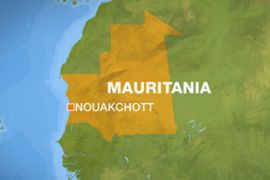Mauritania: Factfile
Mauritania’s popular junta is restoring democracy after nearly half a century of dictatorship.

Published On 6 Aug 2008
After multi-party polls in 1992, Taya headed a series of civilian governments. He was re-elected for a third time in 2003 in a poll which opposition groups said was marred by fraud and intimidation.
A coup in 2005 ended Taya’s two decades of authoritarian rule, However, the military government that took over, pledged a full transition to democracy with presidential polls in March 2007.
In a June 2006 referendum, overseen by the military rulers, voters approved constitutional changes limiting the president to two five-year terms.
Transition
On August 3, 2005, Mauritania entered a transitional phase following the ouster of Taya.
During this transitional period, the Military Council for Justice and Democracy, led by Eali Ouled Mohammed Vall, took control and promised to restore power into the civilian hands through municipal, parliamentary and presidential elections.
The Council granted itself a two-year transitional period, which was later reduced to 19 months.
While in power, the military council took the following actions:
-
Handed down a number of legislative regulations precluding any of the military council’s members from running any elections during the transitional period.
-
Carried out a referendum on June 25, 2006, on the amendments of eight articles in the Constitution which were believed to reinforce the principle of “non-rotation of power”.
-
Conducted municipal and parliamentary elections.
-
Laid emphasis on more than one occasion on the impartiality of the army in relation to the transformation into democracy following the transitional period.
Presidential elections
On March 11, 2007, the first round of presidential elections commenced, marking the end of the transitional period.
A total of 19 candidates were in the presidential race. Prominent among them were Ahmed Ouled Dada, leader of Union for Democratic Forces, and Saleh Ouled Hanana, who led an unsuccessful coup attempt in 2003 against Taya.
Military coups
Since late 1970s, Mauritania saw more than seven coup attempts, some of which succeeded in toppling the regime:
-
July 1978: A non-violent coup ousted Al Mukhtar Ouled Dada, the then president, and Colonel Mustapha bin Mohammed Al Salek. The coup leaders formed the first civil government, led by Sayed Ahmed Ouled Abenjara.
-
March 1981: The coalition for Mauritania, backed by Morocco, launched an unsuccessful coup to oust Mohammed Ouled Hidala, the president, who then appointed Taya as the prime minister.
-
December 1984: Mohammed Ouled Hidala was eventually toppled through a white coup after which Maaouya Ould Sid’Ahmed Taya took control of the reins.
-
October 1987: A coup organised by black officers, loyal to the African Liberation Front in Mauritania, was foiled.
-
June 2003: A bloody coup led by Major Saleh Ouled Hanana also ended in failure.
-
August 2008: The sacked commander of the country’s presidential guards takes control of the presidential palace in Nouakchott. Officers seize Sidi Mohamed Ould Cheikh Abdallahi, the president, along with the country’s interior minister and Yahya Ould Ahmed Waghf, the prime minister in a bloodless coup.
Oil wealth
One of the world’s poorest countries, Mauritania, is also the newest of Africa’s oil producing nations and is pinning its hopes for future prosperity on the exploitation of its offshore reserves of oil and natural gas.
The Chinguetti and Tiof fields are expected to yield millions of barrels of oil.
Source: Al Jazeera